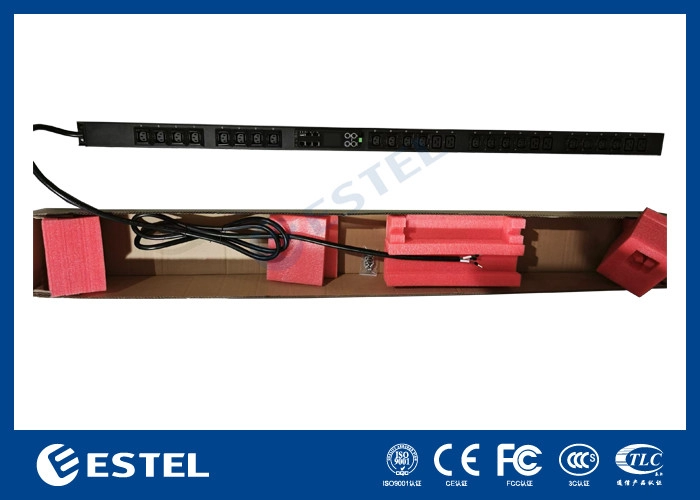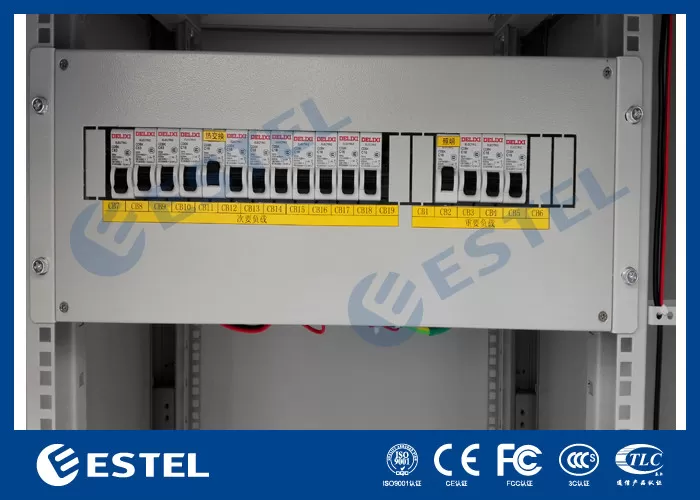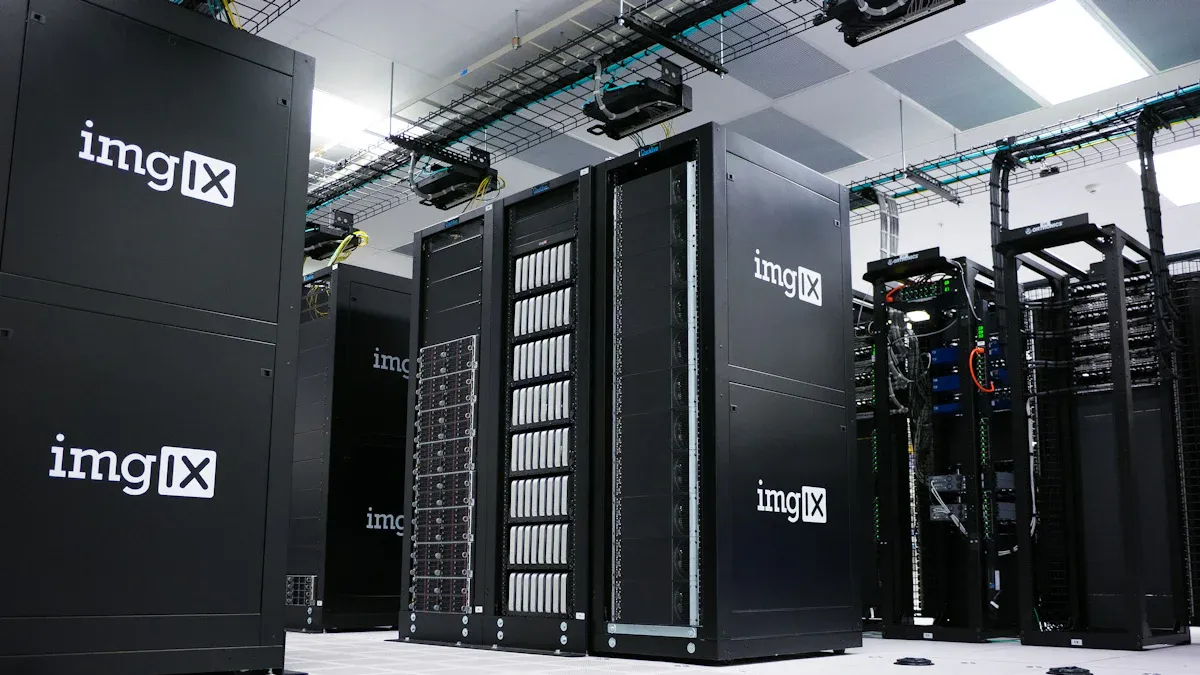How Power Distribution Units Enhance Efficiency in Telecommunications

Power Distribution Units (PDUs) are important in telecommunications. They manage power and keep equipment running smoothly. PDUs send electricity to devices, stopping problems that may harm networks. New features like IoT allow real-time checks and early fixes. This lowers risks and keeps systems safe. As data centers grow for digital services and cloud use, PDUs are needed more. They can grow with networks, making them key for modern telecom systems.
Key Takeaways
Power Distribution Units (PDUs) control electricity for telecom equipment. They make sure devices get enough power and avoid overloads.
Smart PDUs let you check power use and control them remotely. This saves energy and makes systems work better.
PDUs improve telecom system reliability by lowering downtime and keeping users happy.
PDUs can grow with networks, so big changes aren't needed. This makes them important for modern telecom setups.
Advanced PDUs help save energy and protect the environment. They support eco-friendly goals for telecom systems.
Understanding Power Distribution Units
What is a PDU?
A Power Distribution Unit (PDU) sends electricity to many devices. It works as a hub, giving power to servers, network tools, and telecom gear. This helps them run well. PDUs come in simple or smart types. Each type is made for different power needs.
In telecom, PDUs are very important for smooth operations. They have many outlets to connect devices and share power properly. Some smart PDUs let you check and control power from far away. This helps save energy and stops overloads. PDUs are a must-have for modern telecom setups.
Did you know? Smart PDUs can track power use live. This is helpful in data centers where saving power is very important.
Basic functionality and relevance in telecom systems
PDUs send power to connected devices. They make sure each device gets the right amount of electricity. This stops problems like power spikes or overloads. PDUs also help you see how much power is used. You can fix issues and make systems work better.
Here are some main features of PDUs and why they matter in telecom:
Power Distribution: PDUs send power to many devices safely and reliably.
Voltage Transformation: Some PDUs change voltage to match device needs.
Monitoring and Control: Smart PDUs let you check and control power from anywhere.
Load Profiling: PDUs study power use to save energy and cut costs.
Feature | Description |
|---|---|
Function | Sends power to servers, network tools, and telecom gear. |
Components | Includes breakers, transformers, and monitoring tools. |
Applications | Used for power sharing, voltage changes, and studying power use. |
In telecom, PDUs keep systems reliable and ready to grow. As data centers expand for cloud and IoT, strong power tools like PDUs are needed more. Using PDUs makes telecom systems better and ready for future changes.
Pro Tip: Use smart PDUs for your telecom setup. They let you check power live and control it from far away. This makes systems more reliable and easier to manage.
Types of Power Distribution Units
Basic PDUs
Basic PDUs are the simplest kind of Power Distribution Units. They send power to devices but don’t have extra features like monitoring. Think of them as basic power strips made for telecom systems. These PDUs work well in setups where managing power is simple, and reliability is key.
You’ll often find basic PDUs in small telecom cabinets or places with steady power needs. They deliver power evenly, lowering the chance of outages from uneven supply. While they don’t have smart features, they are affordable and easy to set up.
Tip: If your telecom system doesn’t need advanced tools, basic PDUs are a good, reliable option.
Metered PDUs
Metered PDUs do more than just share power. They show real-time data about energy use. Built-in meters help you see how much power each device uses. This helps you find waste and use energy better.
Studies say metered PDUs, with server and airflow fixes, can save 20% energy in data centers. This makes them great for telecom systems wanting to cut costs and help the environment.
Metered PDUs are best for bigger setups where energy tracking is important. Watching power use stops overloads and keeps devices working safely.
Switched PDUs
Switched PDUs give you more control over power sharing. You can turn outlets on or off from far away. This is helpful for telecom systems with spread-out or hard-to-reach devices.
Switched PDUs make work easier by letting you restart or turn off devices remotely. This cuts downtime and makes systems more reliable. They also balance power, so all devices get the right amount.
Pro Tip: Use switched PDUs for better power control in complex telecom setups. Remote features save time and improve efficiency.
Intelligent PDUs
Intelligent PDUs are the most advanced Power Distribution Units today. They do more than just share power. They offer live monitoring, remote control, and smart data tools. These features make them very useful for modern telecom systems.
With intelligent PDUs, you can check power quality anytime. This helps you find and fix problems before they cause trouble. For example, new intelligent rack PDUs have tools to measure power quality. These tools give data to improve power use and keep systems running. Using this data helps create a stable and efficient telecom setup.
Did you know? Intelligent PDUs send alerts when limits are crossed. Warnings can come by text, email, or SNMP traps. This helps stop overloads and system failures.
Here are some main benefits of intelligent PDUs:
They send warnings about possible issues early.
They let you control and check power from far away.
They help save energy and cut down on costs.
Intelligent PDUs track advanced power quality details.
They give live data to help make better choices.
This keeps telecom systems steady and working well.
Adding intelligent PDUs to your telecom system gives better power control. Their smart features improve efficiency and support growing networks. Intelligent PDUs are a great choice for any modern telecom setup.
Benefits of Power Distribution Units in Telecommunications

Better power management
A Power Distribution Unit (PDU) helps manage power well in telecom systems. It makes sure every device gets the right amount of power. This stops problems like overloads or power spikes. PDUs also help save energy by sharing power efficiently. This is very useful in data centers where saving energy lowers costs.
Smart PDUs make power management even better. They let you see how much power each device uses in real time. This information helps you find waste and improve system performance. For example, using smart PDUs in data centers can save energy and keep power steady.
Tip: Use PDUs with surge protection to protect your devices. They stop damage from sudden power surges and keep systems running.
Better system efficiency
PDUs make systems work better by simplifying power sharing and adding monitoring tools. Smart PDUs let you control power from far away. You can restart or turn off devices without being there. This saves time and reduces downtime.
One study showed how smart switches improved systems. After upgrades, outages lasted only 14.4 seconds a year. This was 25% better than systems with fewer smart switches. This shows how PDUs improve operations and service quality.
Circuits Upgraded | Total Savings (2018$) | Savings per Customer (2018$) |
|---|---|---|
15 | $83,849,729.68 | $304.91 |
30 | $126,917,299.35 | $461.52 |
50 | $151,832,853.97 | $552.12 |
Adding PDUs to your telecom system can bring similar benefits. They help monitor and control power, making systems run smoothly and saving money.
More reliability and uptime
Reliability is very important in telecom, and PDUs help keep systems running. They give steady and safe power to all devices. This protects equipment and stops service interruptions, keeping customers happy.
PDUs with monitoring tools make systems even more reliable. They can spot problems before they happen. This lets you fix issues early and avoid downtime. Some PDUs also use predictive tools to plan maintenance. This stops unexpected outages and keeps networks working.
Did you know? Advanced PDUs send alerts when power levels are too high. These warnings help you act fast to avoid system failures.
Using PDUs in telecom systems ensures steady and reliable power. This reduces downtime and helps data centers grow stronger for future needs.
Scalability for growing telecom infrastructures
Scalability is very important for modern telecom systems. As networks grow, systems must handle more demands. Power Distribution Units (PDUs) help telecom setups grow easily. Their design lets you expand power management without big changes.
PDUs are made to be flexible. They work well with current telecom systems. This makes adding devices or upgrading setups simple. For example, in data centers, PDUs share power evenly. This keeps systems steady as they grow.
The modular design of PDUs makes scaling easier. You can add or swap parts when needed. This lowers downtime and saves money. This is helpful in data centers where systems must always work. Scalable PDUs handle power changes quickly, keeping systems efficient.
Tip: Pick PDUs with smart monitoring tools. They show power use as networks grow, helping save energy.
The need for flexible power tools shows why PDUs matter. They grow with your systems to meet future needs. Whether for small setups or big data centers, PDUs support growth and reliability.
Advanced Features of PDUs
Remote monitoring and control
Modern PDUs let you monitor and control power from far away. You can check power use, voltage, and device health anytime. This helps keep systems working well and saves energy.
Remote tools allow fixes without visiting the site. If a device needs restarting, you can do it remotely. This saves time and avoids delays, especially in big telecom setups.
Feature | Description |
|---|---|
Real-time Monitoring | See power use and device health live. |
Remote Management | Fix or adjust devices from anywhere quickly. |
Data-driven Decision Making | Use power data to save energy and cut costs. |
These features make remote control important for telecom systems. They improve efficiency, lower risks, and keep systems running smoothly.
Redundancy and failover capabilities
PDUs with backup paths keep systems running during power problems. If one path fails, another takes over right away. This stops downtime and keeps networks steady.
Backup PDUs are great for critical telecom setups. They protect against outages and equipment issues. Failover systems switch to backups fast, avoiding disruptions.
For example, in data centers, backup PDUs share power across circuits. If one circuit fails, the backup system keeps power flowing. This protects your setup and improves uptime.
Integration with telecom management systems
PDUs work well with telecom management tools to improve networks. They connect with DCIM software to manage power and cooling in one place.
This connection helps track power use and cooling efficiency. It lowers energy waste and keeps systems reliable.
Benefits include:
DCIM software tracks PDUs and other tools for easy management.
Watching power use helps find waste and save energy.
Proactive checks ensure systems meet performance goals.
By linking PDUs with telecom tools, you get better control. This boosts efficiency, saves money, and helps networks grow easily.
Energy efficiency and sustainability
Saving energy and protecting the environment are now top goals in telecommunications. Advanced Power Distribution Units (PDUs) help achieve these by using energy wisely and cutting waste. They share power efficiently, reducing energy loss and boosting system performance.
A key feature of advanced PDUs is real-time monitoring. This lets you see how much energy is used and spot problems quickly. Fixing these problems lowers energy use and saves money. For instance, managers use this data to make energy-saving changes, helping the environment.
Advanced PDUs also work well with renewable energy. They manage power loads and adjust voltage automatically, making renewable energy more useful. This reduces the need for traditional energy and cuts carbon emissions. Studies show these PDUs help data centers meet green goals and follow strict environmental rules.
Aspect | Details |
|---|---|
Energy Efficiency | Advanced PDUs save energy by reducing waste and losses. |
Sustainability | They help data centers cut carbon emissions and meet green goals. |
Technological Integration | Features like load management and voltage adjustment improve energy use. |
Real-time Monitoring | Tracks energy use live to find and fix problems fast. |
Renewable Energy Integration | Supports using renewable energy in data centers effectively. |
Using advanced PDUs helps telecom systems meet global green goals. These tools improve energy use and keep systems eco-friendly and ready for the future.
Tip: Choose PDUs with real-time monitoring to save energy and support a greener telecom system.
Real-World Applications of PDUs

Case study: PDU use in telecom cabinets
Telecom cabinets hold important equipment needing steady power. Adding a PDU helps share power evenly to all devices. Basic PDUs work well in small setups, giving reliable power without breaks. In bigger cabinets, smart PDUs offer extra tools like remote checks and power tracking. These tools let you see energy use and fix waste quickly.
PDUs stop power overloads and give each device the right electricity. This keeps equipment safe and lowers downtime. Their modular design makes them easy to add to current setups. They also grow with your system as it expands.
Example: Smart PDUs in network centers
Network centers (NOCs) depend on smart PDUs for smooth work. These PDUs allow live checks, remote control, and energy management. For example, you can watch power use and change settings from anywhere. Smart PDUs also warn you if power levels get unsafe, so you can fix problems early.
Feature | Benefit |
|---|---|
Live monitoring | Finds waste and improves resource use, cutting costs. |
Remote control | Lets you manage power from far away, saving time. |
Reliability | Watches power to stop failures, keeping systems running. |
Energy efficiency | Cuts waste and saves money with real-time power data. |
These features make smart PDUs essential for NOCs, where smooth and reliable work is key.
Benefits seen in telecom systems
PDUs have improved telecom systems by making power use better and work smoother. Tools like remote checks and power tracking, found in advanced PDUs, give more control over power sharing. As data centers grow, the need for these PDUs rises because they provide strong and efficient power solutions.
Advanced PDUs save energy by cutting waste and lowering costs.
The growth of digital systems increases the demand for PDUs in telecom.
Modular designs make PDUs perfect for expanding telecom setups.
Adding PDUs to your telecom system improves reliability, growth, and energy use. This ensures your setup is ready for future needs.
Power Distribution Units (PDUs) are very important in telecom systems. They help by managing power well, stopping downtime, and growing with networks. Advanced PDUs have tools like remote checks and saving energy, making them a must-have for today’s telecom setups.
Tip: Try intelligent PDUs to control your system better and save money on energy.
Using PDUs keeps your telecom system strong, steady, and ready for future needs. Upgrade now to make your system work its best.
See Also
CALL US DIRECTLY
86-13752765943
3A-8, SHUIWAN 1979 SQUARE (PHASE II), NO.111, TAIZI ROAD,SHUIWAN COMMUNITY, ZHAOSHANG STREET, NANSHAN DISTRICT, SHENZHEN, GUANGDONG, CHINA

